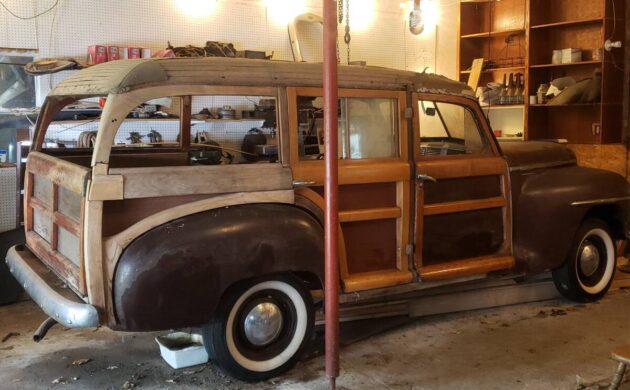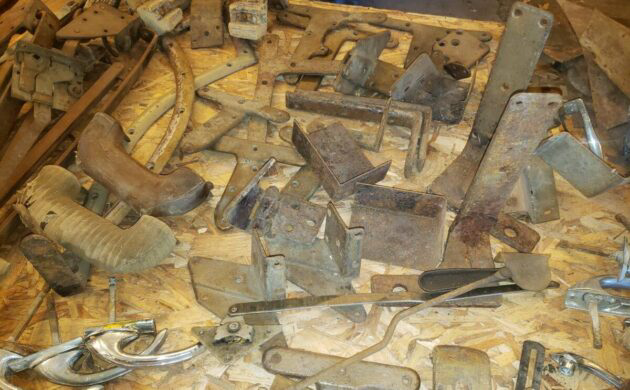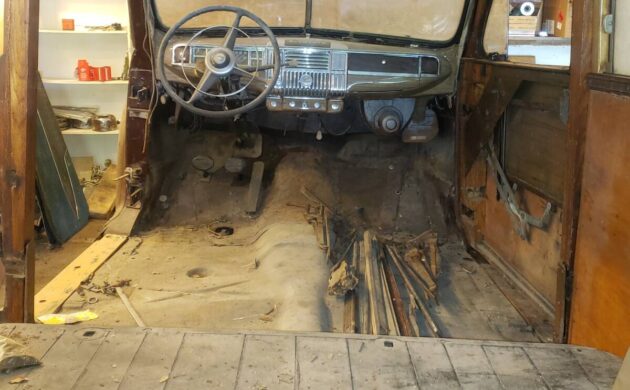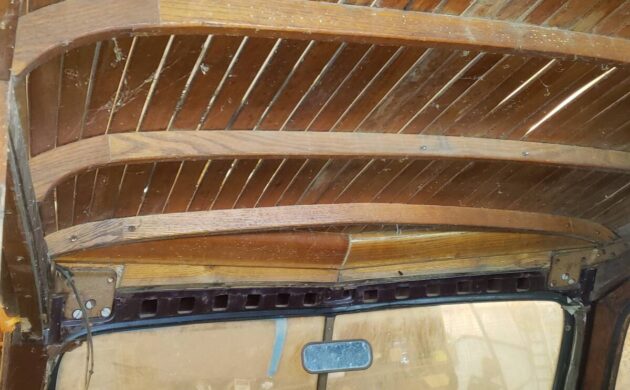Who doesn’t love to at least look at a woody wagon? Even if you wouldn’t own it, the craftsmanship, the beauty, and simply the fact that we don’t make wood cars any longer – evokes admiration. Ornamental mass-produced wood-bodied cars really started with Ford in 1929, who bought timberland to supply milled lumber to body Model A’s. After that, it was everyone in the pool, with offerings from all the major car makers. The “station wagon” – a reference to the original horse-drawn wood carriage that hotels sent to pick up travelers from the train station, was a very popular body style. Here on craigslist is a 1947 Plymouth Woody Wagon (Series P15 Special Deluxe, to be precise) for sale at $9,900, located in Williamston, Michigan. This wagon is said to be a complete car, with enough extra parts to “almost complete a second one”, in case you want double the fun. We have T.J. to thank for this tip!
After WWII, Plymouth recycled its 1942 products when production restarted in 1946. Demand was so strong that it didn’t need new models, a blessing since carmakers didn’t have funds for new designs immediately post-war. So Plymouth vehicles from 1946 through 1948 were nearly identical to its 1942 vehicles – a good thing for restorers since that made parts abundant. Our seller also has abundant parts collected over ten years, as seen in several photos. Other than the abundance of parts and the barest description of the subject car, we don’t know if this vehicle has a working motor or transmission, when it was last on the road, or the condition of the metal panels.
The interior obviously needs finishing along with the rest of the carcass. A restored interior should have a vinyl front bench seat, and two sets of removable rear bench seats, to accommodate eight altogether. All 1947 Plymouths shared a 218 cu. in. inline six-cylinder motor, with a single downdraft carburetor, and a three-speed column transmission. This powerplant produced 95 bhp, which made the 3400 lb Plymouth Special Deluxe station wagon a sluggish performer. In fact, the weight of woodies generally, the hand construction, and the maintenance for the end user all conspired to kill the woody by 1953.
The roof needs its inner padding and outer canvas top. The wood on the body consists of ash ribbing with maple panels. When complete, this wagon would look magnificent, but there’s a long road to travel before that result. Anyone willing to take this one home?







The reason post-war cars were essentially the same as pre-war cars is that automakers were forbidden from working on new designs during the war. The idea was to keep any manufacturer from gaining an unfair advantage. Kaiser-Frazer was exempt from the rule, since they didn’t exist prior to the war, and Studebaker got around the rule by contracting with an outside firm for design.
Sorry to contradict you, but throughout my childhood, my next door neighbor had a 1928 Chevrolet woody wagon that I played in regularly. He would occasionally start it up and tote a bunch of us kids up and down the road. His brother-in-law finally took it (after he passed) and restored it.
It is correct that earlier woodies were available. But they were not production vehicles. Ford was the first on that one. Before 1929, woodies were custom made to buyer specs. Fisher Body did some; so did others. Here’s a story on a slightly later Chev explaining the situation.
https://www.eastbaytimes.com/2016/04/20/me-my-car-1931-chevy-woodie-wagon-an-original-car-2/
I think the price on this car is very reasonable. However, you need to be realistic ,the restoration will not be for the faint of heart. But, for some one who wants a woody and has time , money and dedication ,this will be a great car. I have been down the woody road and it was a great trip.
“The roof needs its inner padding and outer canvas top.”
Yes, it needs the outer top material. but as for the inner padding, there was none, what you see in the photo of the roof interior is what you got when new.
Sadly the guy who restored most of these cars, and had all the specifications for the wood pieces, was effectively put out of business when the entire shop recently went up in flames.
Bummer about the restoration guy. … My information showed that typically there was Everflex padding between the slats and the outer covering.
Michelle, I may have mis-understood your comment, and thought you meant fabric inside like a headliner, when I now think you may have meant inner padding under the outer top material. And yes, there was indeed a light layer of simple white cotton padding laid over the wooden slats [about 1/4″ thick], then the grained top material would be stretched over the cotton, & fastened in place.
And FWIW, Everflex is the trade name for the high-grade vinyl top material used on Rolls-Royce and Bentley cars, starting with the Silver Shadow series.
A older fellow I knew( he’s passed on) had ten or twelve cars and two of them were Chrysler Town and Country’s, a sedan and a convertible. They were beautiful original paint/interior cars that he had revarnished the wood on. He said he scraped the old varnish off with box cutter blades. Took him longer to do it that way but they were gorgeous.
Your friend who used box cutter blades . . . that may sound crude and primitive, but it is not. We all think of “sanding” when we see something like this, but “scraping” is far faster and leaves a cleaner surface. “Sanding” essentially “wears out” the fibers on the surface, and they fall off. “Scraping” cuts them cleanly at the surface. The resulting finish is far better when the surface is scraped. Lots of things can be used. My Dad showed me how to use broken glass bottles to scrape things like chair rungs and slats.
MGSteve.
The man who ran the wood shop in my restoration facility also built furniture and did restoration/repairs for the Smithsonian. He was a 3rd generation Haitian furniture builder and loved the challenges in building missing wood parts of a car body.
He had a shelf filled with small wooden boxes, each held pieces of glass, some flat, some from broken bottles. Each box held specific curves in the sharp edges, and he used them frequently to sculpt wood after the saws and chisels were finished.
The number one reason he used the glass shards was economic. He learned his craft in Haiti, where sandpaper was very expensive, but broken glass was everywhere.
The guy that had the woody restoration shop that was burned down featured on “Barnfind Hunters” awhile ago.
I’d love to know the back story on this woody. The guy was collecting parts for 10 years and then….put it up for sale. Most likely life got in the way, but that’s got to be frustrating to spend so much time and effort collecting parts only to sell the project. Seems like a reasonable price for what it is and all the parts.
theGasHole,
Over the years I’ve bought quite a few project cars, and in every case the situation fit into one of these scenarios:
Top 6 reasons unfinished project cars are sold:
1. Money issues.
2. Owner dies.
3. Owner becomes sick, can no longer work.
4. Owner realizes it’s a lot easier to take apart than to put back together.
5. Owner fails to take notes and photos, can’t remember “what goes where”.
6. Loss of a place to work on the car.
I’ve bought a few that fell into categories 4 & 5, those are the worst ones to get.
This particular one kinda gets me though because obviously the seller spent so much time collecting all the parts, and never got a chance to even drive it. On the positive, sounds like it’s gone to a good home!
Bought it and brought it all home.
Tons of extra parts and the owner is a retired physics and sailing school teacher heading to Maine.
His entire home was filled with an unbelievable lifetime collection and display of ingenuity throughout, showcasing his talents in all areas.
From the room with a complete soda fountain shop with a classic Wurlitzer, to the aviation rooms filled with 1/4 RC’s, to the train layout with Christmas and winter theme and much more. Oh, plus the complete wood shop and additional classic cars.
A lifetime well-spent and he’s not done!